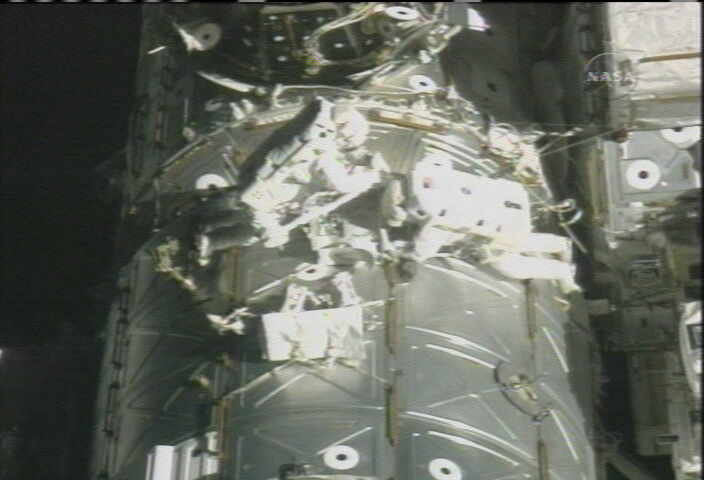Spacewalkers Test Fire Shuttle Repair Goo Gun

Thisstory was updated at 3:47 a.m. EDT.
HOUSTON - Two spacewalking astronauts test fired a high-tech caulk gun filledwith goo outside the International Space Station (ISS) Thursday to determinewhether it?s a viable repair tool for dinged shuttle heat shields.
Shuttleastronauts Mike Foreman and Robert Behnken squirted a pink, putty-likesubstance into intentionallydamaged shuttle tiles during their six-hour and 24-minute spacewalk to testhow the material behaves in the weightless vacuum of space.
?It goesdown really well,? Foreman said as he tamped down the thick goop with asponge-like tool. ?It really is like a loaf of bread with a lot of littlebubbles in there.?
NASAengineers developed the shuttle tile repair tool, known as the Tile RepairAblator Dispenser (T-RAD), in the wake of the 2003 Columbia disaster to fixdings in the thousands of ceramic tiles that line an orbiter?s underbelly.
The shuttleColumbia disintegrated as it reentered the Earth?s atmosphere, killing itsseven-astronaut crew, due to a hole in the fragile carbon-composite heat shieldpanels along its left wing. NASA has developed a black heat-resistant putty forminor panel damage, with the caulk gun and goo, small patches and a gray primerwash reserved for dinged tiles.
?Havingthis in our bag of tricks is really going to be helpful,? Behnken said beforetoday?s spacewalk.
Get the Space.com Newsletter
Breaking space news, the latest updates on rocket launches, skywatching events and more!
Thursday?sexcursion began at 6:04 p.m. EDT (2204 GMT) and marked the fourth of fivespacewalk planned for NASA?s STS-123 shuttle flight aboard Endeavour. Theshuttle astronauts have delivered a new station crewmember, a Japanese moduleand a massive Canadian maintenancerobot called Dextre to the ISS during their 16-day mission.
Tilerepair test
The T-RADtool, a slimmed down version of a balky backpack-mounted device, was the onlyheat shield fix yet to be tested in orbit.
?I?mthrilled with what we saw today,? said ISS flight director Dana Weigel afterthe spacewalk, adding that T-RAD could also be used to mend torn shuttleinsulation blankets. ?It behaved very similar to what we saw on the ground, sothat gives me a lot of confidence.?
During thetest, Foreman squeezed the trigger of his gun-like T-RAD device, which thenmixed two different compounds into an ablative material as it squirted out intothe damaged shuttle tile samples. Some of the samples mimicked an actualtile gouge from Endeavour?s last flight in August 2007, as well as icedamage from post-Columbia tests on Earth.
?You are CaptainT-RAD today, Mr. Goo,? Endeavour astronaut Rick Linnehan told the googun-toting Foreman from inside the shuttle. ?You?re in control.?
NASAengineers hoped to learn how the T-RAD material behaved in space, and whetherbubbles would rise to the surface or cause the goo to swell like rising bread.
?We?rereally captivated by what you?re doing,? astronaut Steven Robinson told thespacewalkers from Mission Control here at NASA?s Johnson Space Center. ?You?relike brain surgeons up there.?
Foreman andBehnken reported seeing bubbles and some swelling, but were apparently able topat it down with their tools.
?I expectthat this [demonstration] will be successful and may actually teach ussomething,? said John Shannon, NASA?s space shuttle chief, before the flight.?Obviously, we have not had any tile damage since returning to flight that hasmade us seriously consider this repair.?
Thursday?sspacewalk marked the 108th spacewalk outside the ISS and the second careerexcursion for Behnken and Foreman, both of whom are making their firstspaceflight.
Behnkenended the orbital work with 13 hours and 17 minutes of spacewalking time, whileForeman concluded with 13 hours and 32 minutes. Both astronauts willparticipate in their mission?s fifth spacewalk on Saturday.
Thespacewalkers also replaced a faulty circuit breaker outside the station, butcould not rewire an electrical line feeding it due to a stuck connector. Theyalso released a series of locks on a station module, hunted for a lost pin in aberthing port - unsuccessfully - and removed a glove-like thermal cover fromone of the Dextre robot?s hands.
?It lookspretty good, a monstrosity,? Foreman said of the robot. ?Monstrous.?
NASA isbroadcasting Endeavour's STS-123 mission live on NASA TV. Click here for SPACE.com'sshuttle mission coverage and NASA TV feed.
- NEW VIDEO: Space Station's Dextre Robot, AKA 'Gigantor'
- NEW GALLERY: Launch Day for Shuttle Endeavour
- NEW VIDEO: Japan's First Space Station Module
Join our Space Forums to keep talking space on the latest missions, night sky and more! And if you have a news tip, correction or comment, let us know at: community@space.com.

Tariq is the Editor-in-Chief of Space.com and joined the team in 2001, first as an intern and staff writer, and later as an editor. He covers human spaceflight, exploration and space science, as well as skywatching and entertainment. He became Space.com's Managing Editor in 2009 and Editor-in-Chief in 2019. Before joining Space.com, Tariq was a staff reporter for The Los Angeles Times covering education and city beats in La Habra, Fullerton and Huntington Beach. In October 2022, Tariq received the Harry Kolcum Award for excellence in space reporting from the National Space Club Florida Committee. He is also an Eagle Scout (yes, he has the Space Exploration merit badge) and went to Space Camp four times as a kid and a fifth time as an adult. He has journalism degrees from the University of Southern California and New York University. You can find Tariq at Space.com and as the co-host to the This Week In Space podcast with space historian Rod Pyle on the TWiT network. To see his latest project, you can follow Tariq on Twitter @tariqjmalik.









